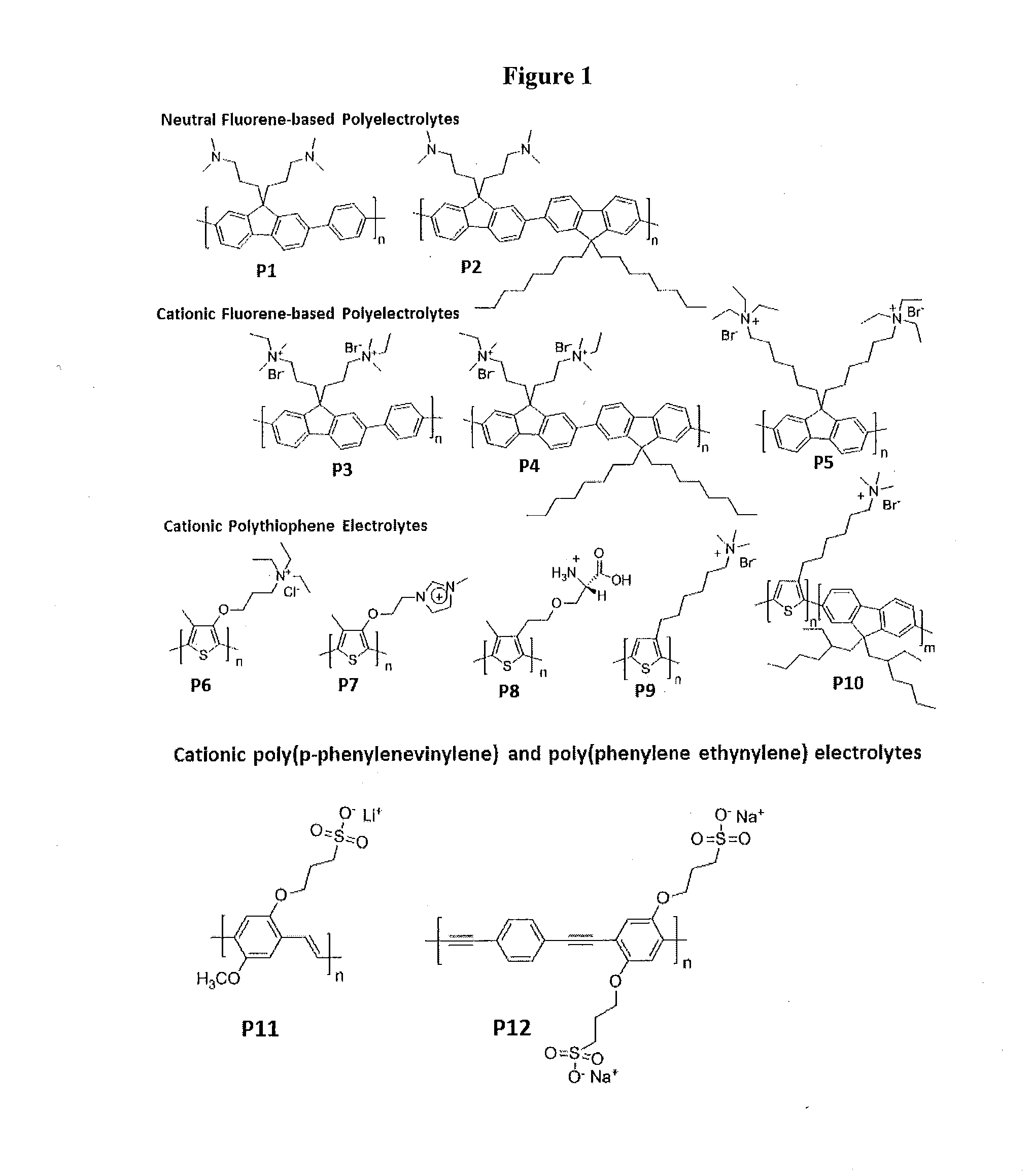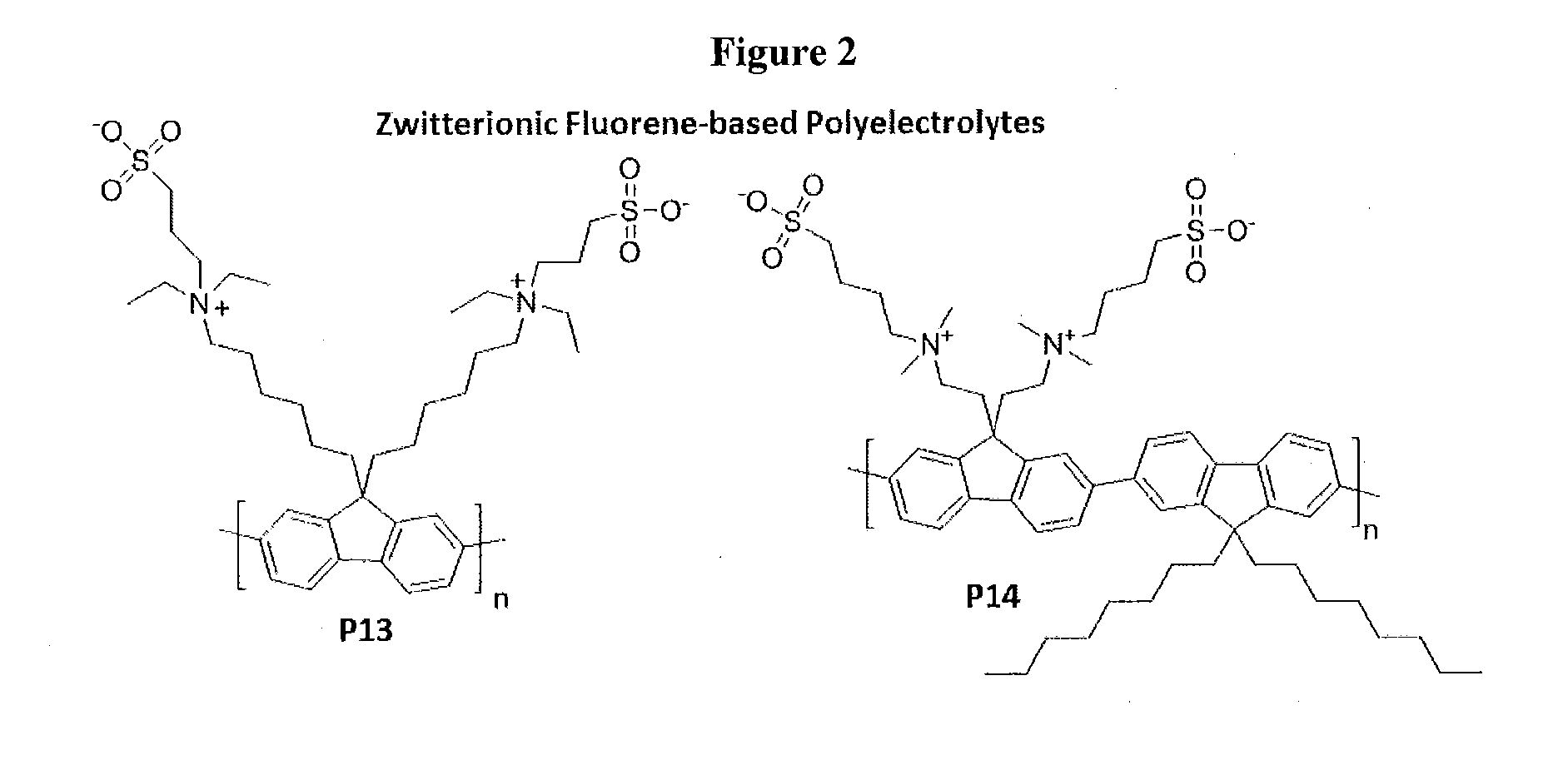Novel Zwitterionic Polyelectrolytes as Efficient Interface Materials for Application in Optoelectronic Devices
a technology of zwitterionic conjugated polyelectrolytes and interface materials, applied in semiconductor devices, solid-state devices, electrical apparatus, etc., can solve the problems of counter ions, mobile counter ions, and inability to extend in electronic devices, and achieve the effect of long turn-on times
- Summary
- Abstract
- Description
- Claims
- Application Information
AI Technical Summary
Benefits of technology
Problems solved by technology
Method used
Image
Examples
example 1
Synthesis of Linear Electron Blocking ZCPES (Structures 1-3)
[0013]Common organic chemistry reactions for the synthesis of the functional monomers M1-M4 (Scheme 1). The key intermediate building block is the 2,5-dibroino-3-((diethylamine)methyl)thiophene M4. The synthesis of M4 starts with the reaction of the commercially available 3-thiophene methanol with bromine to obtain M3 and then subsequent reaction with diethylamine to yield M4. The distannyl functionalized monomers M1 and M2 can be synthesized by addition of trimethyltin chloride and butyl lithium to benzo[1,2-b:4,5-b]dithiophene and dithieno[3,2-b:2′,3′-d]silole, respectively.
[0014]Stille cross-coupling polymerization reaction between the distannyl functionalized monomers M1 and M2 with M4 by using Palladium catalysts, for example tetrakis(triphenylphosphine)palladium(0) [Pd(PPh3)4] or tris(dibenzylideneacetone)dipalladium(0) [Pd2(dba)3] for the synthesis of the precursor polymers BDTAT and SiDTAT, respectively.
[0015]Grigna...
example 2
Synthesis of Brush-Type Electron Blocking ZCPEs (Structures 4-6)
[0017]The ever more demanding requirements for novel polymeric materials raise the necessity to be able to combine all kinds of polymers in an easy manner. To overcome this challenge, polymer chemists have explored a variety of approaches to combine different polymer chains. In addition, the combination of synthetic organic chemistry and polymer chemistry is a very promising approach to build novel structures by coupling preformed polymers, which allows the combination of the state-of-the-art in living / controlled polymer chemistry with the best known organic coupling procedures. In this respect, the concept of click chemistry seems to be the ideal method to couple preformed polymer structures. Click chemistry comprises the metal catalyzed azide / alkyne ‘click’ reaction (a variation of the Huisgen 1,3-dipolar cycloaddition reaction between terminal acetylenes and azides).
[0018]Side-chain modified conjugated polymers synth...
example 3
Synthesis of Linear Hole Blocking ZCPES (Structures 7-8)
[0019]Reduction of 4,7-dibromo-[2,1,3]benzothiadiazole with NaBH4 provide 1,2-diamine-3,6-dibromo benzene (Neophytou, Ioannidou et al. 2012) that will be condensed with appropriate 1,2-dicarbonyl or keto-derivatives to give the corresponding quinoxaline M5 and 2H-benzimidazole M6 (Scheme 3). Stille cross-coupling polymerization reaction between the distannyl phenyl ring, M4 and either M5 Or M6 by using Palladium catalysts, for example tetrakis(triphenylphosphine)palladium(0) [Pd(PPh3)4] or tris(dibenzylideneacetone)dipalladium(0) [Pd2(dba)3] for the synthesis of the precursor polymers PhQXAT and PhBzImAT and subsequently, a one-step reaction with cyclic 1,4-butane sultone directly yields the zwitterionic target linear polymers, PhQXBST and PhBzImBST. The zwitterionic sulfobetaine side groups will be formed under relatively mild reaction conditions.
PUM
| Property | Measurement | Unit |
|---|---|---|
| mechanical flexibility | aaaaa | aaaaa |
| wettability | aaaaa | aaaaa |
| adhesion | aaaaa | aaaaa |
Abstract
Description
Claims
Application Information
 Login to View More
Login to View More - R&D
- Intellectual Property
- Life Sciences
- Materials
- Tech Scout
- Unparalleled Data Quality
- Higher Quality Content
- 60% Fewer Hallucinations
Browse by: Latest US Patents, China's latest patents, Technical Efficacy Thesaurus, Application Domain, Technology Topic, Popular Technical Reports.
© 2025 PatSnap. All rights reserved.Legal|Privacy policy|Modern Slavery Act Transparency Statement|Sitemap|About US| Contact US: help@patsnap.com



